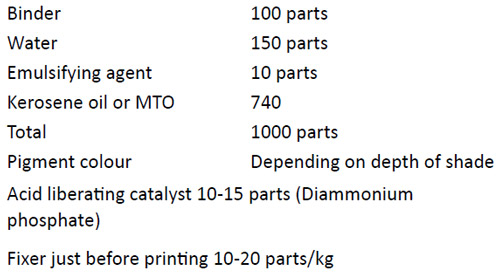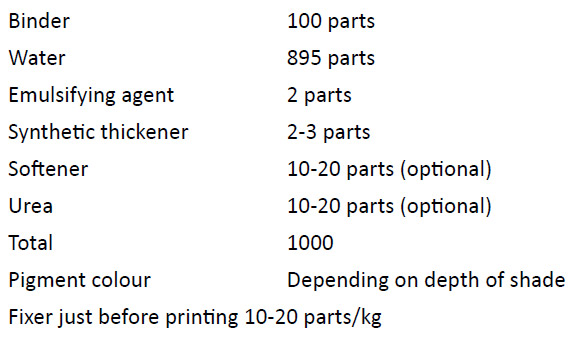Printing with dyes and pigment colours is based on different chemical principles. It is therefore, essential to understand the difference between dyes and pigments
Difference between dye and pigment
| Dye | Pigment |
|---|---|
| Dye is water soluble or can be solubilised in water | Pigment is water insoluble |
| Dye has affinity to fibre on which it is applied | Pigment does not show any affinity to fibre |
| Dye is fixed on fibre be means of suitable bond formation between dye and fibre. The bonds involved between dye-fibre are hydrogen bonds, Ionic or electrostatic bond and covalent bond. The nature of bond formed depends on dyefibre system | Since there is no interaction between pigment and fibre, the pigment is fixed on fibre by means of an external agent known as binder, which provides linkage between pigment and fibre. |
Pigment Binder
Binder is a pre-polymer available in the form of an aqueous emulsion (milk like liquid)23.
Mechanism of pigment colour fixation
The mechanism of pigment colour fixation on fibre is schematically shown below

In pigment printing the sequence of operation is
Print Dry Cure24
The print paste essentially consists of Pigment colour, Binder, Thickener and fixer.
After printing the water from print paste at the printed portion is evaporated during drying. After the evaporation of water the pigment colour, binder and thickener are present on the fibre in the form of design. When the printed fabric is subjected to curing after drying, the binder polymerises and forms a strong transparent film in which pigment colour is embedded. The binder film also shows strong adhesion to the fabric on which it is printed. Thus the fixation of colour on fabric is through the polymeric film of binder.
Fastness property of pigment colour
The fastness property of pigment colour on the fabric depends on the adhesion between binder film and fibre and also on the strength of the binder film. Stronger the adhesion and stronger the film better would be fastness property. Pigment colours being insoluble in water usually show good wash fastness but the binder film can be easily abraded therefore, pigment colours show poor rubbing fastness particularly wet rubbing fastness.
24 Curing involves heat treatment at 140-150oC for 4-5 minutes
Choice of thickener
Conventional thickeners such as guar gum, gum Arabic, starch, sodium alginate etc. used for dye printing are not suitable for pigment printing because of the interaction between binder and thickener. Such interaction between binder and conventional thickener will have following drawbacks
- Dull prints
- Low rubbing fastness
- Harsh feel of fabric
Ideal thickener for pigment printing
The ideal thickener for pigment printing is known as zero solid content thickener. This means that no residue of the thickener should be left at the printed portion after drying so that during curing the pigment colour is embedded in the binder film only. Zero solid content thickener would be free from these drawbacks mentioned above when conventional thickener is used. This means that the print would be bright having good fastness property and soft feel of the fabric at the printed portion. The thickener which meets these requirements is emulsion thickener prepared by the emulsification of water in kerosene or mineral turpentine oil (MTO) with the help of suitable emulsifying agent. Zero solid content thickener also helps in eliminating washing after printing.
Preparation of oil in water emulsion
Typical recipe for preparation of oil in water emulsion for pigment printing is as follows
Procedure of preparation of oil in water emulsion thickener
Mix the required quantities of binder, water and emulsifying agent. After this add kerosene or MTO slowly with high speed stirring. After the complete addition of kerosene or MTO continue stirring for 15 minutes till consistent viscous paste is obtained. Since binder is in liquid form it is better to add it during the preparation of emulsion thickener.
If binder is added after the preparation of emulsion thickener then its viscosity would be decreased which may not be suitable for printing.
Drawbacks of emulsion thickener
Though emulsion thickener is ideal for pigment printing, it is associated with following drawbacks
- Kerosene and mineral turpentine oil (MTO) are flammable and therefore there is danger of fire hazards during storage
- During drying and curing if the exhaust system is not good, there is accumulation of oil vapours which may catch fire at the work place
- Kerosene oil or mineral turpentine oil gives smell which might be retained by the fabric which is not acceptable commercially
- In the absence of proper exhaust system in the work place which is normally the case in block printing units, the vapours of kerosene/MTO spread in the work place during printing operation posing health hazards to the block printers and other work force.
- During drying and curing the vapours let out in the atmosphere cause environmental pollution
For the above reasons the emulsion thickener though ideal is not used for pigment printing.
Synthetic thickener
The conventional thickeners used for printing of dyes are not suitable for pigment printing because of the problems of dullness of prints, low fastness properties and harsh fabric feel at the printed portion. Emulsion thickener though ideal is not suitable on the grounds of health and environmental hazards. Through exhaustive research synthetic thickener has been marketed as a substitute for emulsion thickener for pigment printing. These are also known as very low solid content thickeners.
Characteristics of synthetic thickener
Several trade products are available. All these products are characterized by following features
- Printable viscosity at very low solid content in the range of 1-2%.
- No need of kerosene or MTO for the preparation of thickener
- Chemically these thickeners are copolymers of acrylic acid therefore they are also known as polyacrylates
- These thickeners are available in the form of paste
- The build-up of viscosity takes place on dilution with water or on addition of volatile alkali like aqueous ammonia solution
Drawbacks
- Synthetic thickeners are very sensitive to salt in water therefore soft water is essential for print paste preparation
- The thickener carry water content of more than 95%, therefore and hence more time is required for the drying of printed fabric
- Because of low solid content and high water content the saturation of print block is difficult therefore; the blotch prints many times appear uneven
Preparation of thickener paste
There are two types of synthetic thickeners are available in the market
1. Those that swell in water
2. Those that swell in alkali
There is variation of recipes for these two types of synthetic thickeners
1. Thickener with water

Mechanical high speed stirrer is essential for mixing above components.
2. Thickener with alkali
The print paste composition is as above except 10-20 parts of ammonia solution is essential for development of viscosity. Manufacturer’s recommendation must be followed during the preparation of printing paste.
Leave a Reply